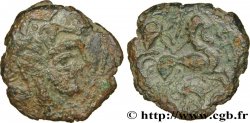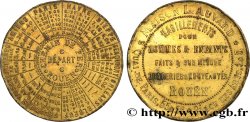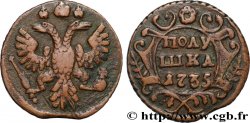fme_658655 - FREEMASONRY Médaille, Célébration de la glorieuse journée de Friedland, La Parfaite Union, l’Humanité, les coeurs constants
1 500.00 €约 12255.00 CNY
数量
加入购物车

种类 Médaille, Célébration de la glorieuse journée de Friedland, La Parfaite Union, l’Humanité, les coeurs constants
日期: 1807
铸币数量 200
材质 copper
直径 53,5 mm
模子方针 12 h.
重量 62,69 g.
侧面 lisse
印模 sans poinçon
关于品相的说明
Patine hétérogène avec du rouge de frappe encore visible. Présence de coups et rayures, des frottements dans les champs. Exemplaire percé à 12 heures et coups sur la tranche
出版目录中的项代码 :
家谱
Cet exemplaire provient de la Collection Charlet
正面
正面的文字 LE G.AL SENATEUR VALENCE G:. R:. DE. S:. M:. LE ROY DE NAPLES S:. G:. M:. AU G:. O:. DE FRANCE // HUMANITE - COEURS CONSTANTS - PARFAITE UNION // A / L’UNION / ETERNELLE / DES LOGES / DANS LE SEIN / DE CELLE DE / LA PARFAITE UNION.
正面的说明书 Légende circulaire et en 7 lignes dans un triangle.
正面的翻译 Le général Sénateur Valence, Grand Représentant de sa Majesté le roy de Naples, Souverain Grand Maître au Grand Orien de France.
背面
背面的文字 AUX LOGES REUNNIES - DE L’ORIENT DE GRENOBLE // 12 / JUILLET 5807:. / CELEBRATION DE LA / GLORIEUSE JOURNEE / DE FRIEDLAND.
背面的说明书 Légende circulaire et en 5 lignes entre un compas et une équerre, entouré par une couronne de laurier.
评论
Général Cyrus de Timbrune de Thiembronne de Valence, comte de Valence (1757-1822), grand représentant du Grand Maître du Grand Orient de France, sénateur de l’Empire nommé à Grenoble.
General Cyrus de Timbrune de Thiembronne de Valence, Count of Valence (1757-1822), Grand Representative of the Grand Master of the Grand Orient of France, Senator of the Empire appointed to Grenoble
General Cyrus de Timbrune de Thiembronne de Valence, Count of Valence (1757-1822), Grand Representative of the Grand Master of the Grand Orient of France, Senator of the Empire appointed to Grenoble








 对产品描述纠错
对产品描述纠错 打印
打印 分享我的选择
分享我的选择 提问
提问 Consign / sell
Consign / sell
 产品介绍
产品介绍















